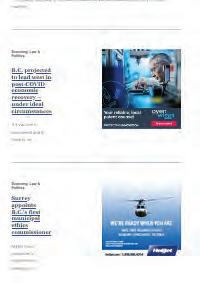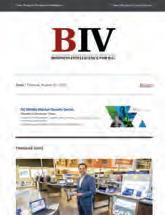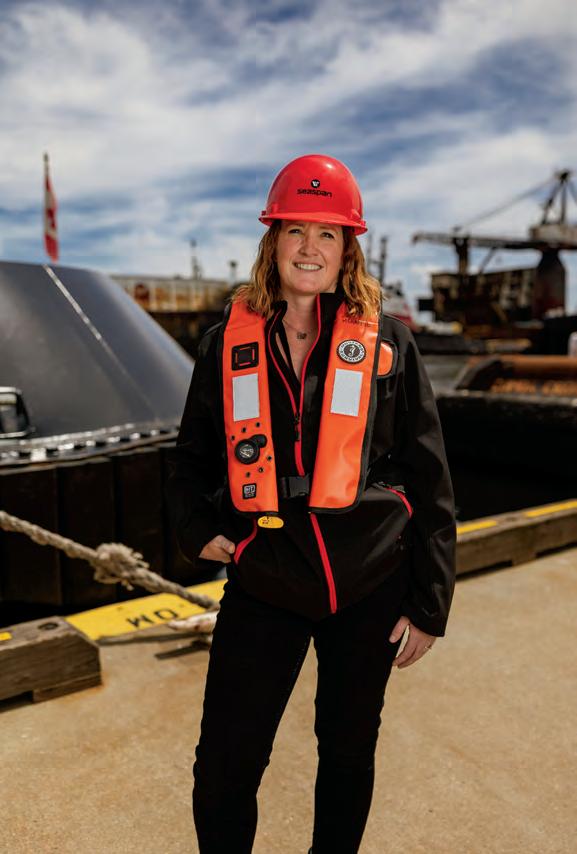





























By the age of 40, one of every two Canadians will have or will have had a mental illness. And in a given year, 20 per cent of the national population will directly experience a mental health issue in some form, according to data collected by the Canadian Mental Health Association
The data is clear, and our collective conversations about mental health and well-being need to catch up to it. No person can reasonably claim that they are protected from such problems, and immune to the challenges they represent. Doing so only masks the immense mental challenge before us.
Over the three decades from 2011 to 2041, the Mental Health Commission of Canada estimates the cumulative economic impact of the direct costs tied to mental health problems will exceed $2.3 trillion. This is a significant burden for health-care systems that are already underfunded and struggling to maintain our physical health.


In the workplace, lost productivity due to mental illness is expected to reach $16 billion per year by 2041. If Canada fails to seriously invest in improving mental health outcomes, the commission anticipates inaction on this file will continue to cost the Canadian economy upwards of $50 billion per year.
The imperative to act is evident, and the response must be led in part by business. The poor current state of our mental health infrastructure presents a real cost to business, just as it offers an opportunity to do business better. Thoughtful, holistic approaches to supporting workers’ mental well-being is not only the responsible path forward, but an effective strategy for attracting, engaging and retaining teams.
The employee experience – and, therefore, productivity and culture – cannot be separated from health. For better or worse, healthy organizations rely on holistically healthy people. This is an investment and growth opportunity that can be led by businesses.


Commercial aviation and marine shipping need all the help they can get in kicking the fossil fuel habit.
Long-haul truckers also need viable options.
Will any of that help be forthcoming from B.C. or elsewhere across Canada?
The smart money would say no; clean energy opportunities disagree.
Given the country’s track record of dithering and delay over any resource infrastructure project of national significance, it would be hard to argue against the smart money bet.
Canada’s stumble out of the gate in the global liquefied natural gas (LNG) market sweepstakes confirms its entrenched minor-league mind-set.
Consider that B.C. and the rest of Canada have some of the world’s best natural gas reserves available to meet the growing world demand for lower carbon-intensive fuels, but of the 18 LNG export projects proposed in Canada, only one large export facility is under construction. Meanwhile, in the politically dysfunctional United States, seven have been built since 2014 and another five are under construction.
According to a February report from Wood Mackenzie , another 16 LNG projects are planned on the U.S. Gulf coast and the added capacity from those projects would make the U.S. the world’s largest LNG supplier. The report estimates that, if the majority of the projects reach a final investment decision, US$100 billion could be invested in them over the next five years.
Canada can avoid stumbling out of the gate on the next big energy market opportunity, unless, of course, it insists on adhering to its tradition of failing to capitalize on its energy and innovation potential.
The hydrogen economy has come knocking.
Last summer, it came knocking in the form of the German-Canada Hydrogen Alliance (GCHA). Observers would rightly argue that the alliance thus far is only a joint declaration of intent between the two countries.
Science would argue that hydrogen is still many miles from energy market viability.
But those arguments aside, the alliance is a start.
And for commercial aviation, long-haul trucking and
deep-water shipping, three of the most difficult transportation sectors to electrify, it’s a start that provides light on the decarbonization horizon.
The alliance, as Heather ExnerPirot has said, is also a multi-dimensional opportunity.
Speaking on a Macdonald-Laurier Institute (MLI) panel last September, the MLI senior fellow pointed out that being a preferred source of hydrogen for Germany’s green energy transition is one element of that opportunity. Another is the potential to build a cohesive national energy outlook, which, up until now, has been anything but.
Exner-Pirot added that it is not a case of LNG versus hydrogen.
“This is an opportunity. There are multibillion-dollar investments already in Western Canada. There are $100 million-plus investments in Eastern Canada industries interested in this. And so, it’s something that [for] people on all sides maybe finally hydrogen is what will bring natural resource opinions together in Canada.”
That is optimistic, considering how politicized natural resource development in Canada has become.
And that, Exner-Pirot conceded, is a problem.
“We are going to have to change our mindset in terms of [yes] we want to build projects; we don’t want to stop projects. And if we were to build a hydrogen economy, there will need to be smoother systems that are not adversarial. Right now, the regulatory system in Canada is very adversarial in that it seems like the regulators are looking at ways to stop or prevent or apply burdens [to energy development projects].”
Canada consequently misses a lot of economic opportunities.
company’s CEO Remi Eriksen estimated that the investment required to increase hydrogen’s role in the global energy mix to five per cent by 2050 would be roughly US$7 trillion.
And, according to the federal government’s Hydrogen Strategy for Canada report, B.C.’s export potential alone for hydrogen has been estimated at $15 billion by 2050.
Little wonder then that Canada’s ambition today is to become one of the world’s top three producers of clean hydrogen.
Right now, the regulatory system in Canada is very adversarial in that it seems like the regulators are looking at ways to stop or prevent or apply burdens [to energy development projects]
The GCHA could help ensure that it doesn’t miss the opportunity to become a global supplier of low-carbon energy. The alliance works for both countries on several fronts. Canada and Germany share many common values, including democratic principles, free trade and climate protection.
The MLI’s Canada and the Energiewende report states therefore that Canada has the potential to become a major exporter of reduced carbon energy, “including hydrogen, for Germany and Europe.”
And unlike LNG, the report opines, “hydrogen has support across political and geographic lines, for now, and as such the social licence to move more quickly.”
But Canada does not move quickly when it comes to resource development, and it will need to if it hopes to reap the potential of the Canadian-German partnership, because, as Jens Honnen pointed out during the panel discussion, clarity and commitment are needed on both sides of that partnership.
The consultant for Adelphi , a European environmental and development think tank, said LNG suppliers and customers need long-term commitment and certainty.
The same would apply to hydrogen suppliers and customers. No commitment, no contract; and no contract, no investment. But there is certainty in clean energy’s economic potential.
The International Energy Agency (IEA) estimates the global market for mass-manufactured clean energy technologies alone will be worth US$650 billion by 2030.
In his opening remarks at DNV’s June 14 hydrogen outlook, the maritime risk management
Good luck with that, considering its sub-par record for developing its natural gas export infrastructure and its LNG markets in a world hungry for lower carbon energy alternatives.
Commercial aviation and deep-water maritime shipping are at the front of the line pushing for green transportation alternatives.
The long-haul trucking sector also needs directions to a lower carbon future.
Transportation is the second largest source of greenhouse gas emissions in Canada. Its 25 per cent contribution is just marginally below the oil and gas sector’s 26 per cent. Gasoline and diesel account for around 93 per cent of the energy used today in Canada’s transportation sector.
As with aviation and maritime shipping, electrifying that sector today is neither technologically viable nor commercially practical. Battery size and recharging time say it is not so.
Just ask Dave Earle.
As the BC Trucking Association CEO previously told BIV, current power storage technology requires batteries that are too large and recharging times that are too long to make them economically viable for trucks hauling freight over long distances.

For Earle, the practical alternatives to diesel are limited.
Hydrogen is one of those alternatives.
Along with LNG, it is also a future propulsion alternative for the world’s container shipping fleet when used in fuel cells to convert green fuels into mechanical energy.
And it promises to be in the future low-carbon energy mix for Japan and other major energy importers in Asia.
Kenryo Mizutani , deputy director and legal counsel for Japan Organization for Metals and Energy Security (JOGMEC), told a Feb. 14 Canada West Foundation panel discussion on Canadian clean energy opportunities in
Japan and Korea that Japan’s most recent energy plan identifies hydrogen as a key future resource “that’s going to be there together with crude oil and natural gas and other major energy forms. And Japan has a concrete plan of using hydrogen for natural-gas-powered plants [with] possibly up to 30 per cent of hydrogen mix.”
The hydrogen market in a lower-carbon world therefore includes many large and lucrative opportunities.
B.C. and the rest of Canada should not be late to this economic opportunity party.
The German-Canada Hydrogen Alliance is a start; B.C.’s goal to be a world-leading hydrogen economy by 2050 is an admirable target.
But neither will get Canada into the hydrogen profit party without major infrastructure investments and national focus and collaboration.
As Matthew Klippenstein told the MLI panel: “Hydrogen is a great opportunity for Canada.”
The Canadian Hydrogen and Fuel Cell Association’s regional manager for Western Canada and branch manager for Hydrogen BC pointed out that the demand for energy in a world of eight billion people is only going to grow.
“You know, we have had, I would guess, a comparatively slow last two years on the energy side, we can be an energy superpower, we should be an energy superpower, our European allies are looking to us to provide that.”
He added that energy is fundamental to raising the economic well-being of the world’s population.
“The more energy humans use, the better. Human development is strongly correlated with … literacy, mortality, gender equality, everything.” •
Vancouver’s lone vehicle hydrogen refuelling station at Granville and 71st | CHUNG CHOWIn a 2021 paper, Mental Health Research Canada warned of a pending “echo pandemic” –one that would be more mental than physical.
“The COVID-19 pandemic will likely result in a large increase in the incidence and prevalence of anxiety and depression and experts are already warning of an ‘echo pandemic’ of mental health problems,” the paper warned. WorkSafeBC confirms that mental health claims are indeed up. It accepted 1,997 psychological injury claims in 2022 – a 14 per cent increase over 2021 and a 227 per cent increase since 2017. The No. 1 sector for psychological injury claims in 2022 was nursing, followed by paramedics, social and community service workers, corrections officers and teachers and teachers’ assistants. More than 60 per cent of accepted psychological injury claims stemmed from traumatic incidents.
More generally, Canadian workers may be suffering from increased stress and burnout – a consequence of the “great resignation” – that can cause or aggravate anxiety and mood disorders, depression or substance
abuse.
There were more than 900,000 unfilled job vacancies in Canada in 2022, which suggests many Canadian workers may be struggling with increased workloads and workplace stress.
But there may also be increased reporting of issues that went unreported in the past, thanks to growing awareness and acceptance of mental health issues as a legitimate workplace hazard. About 30 per cent of disability claims in Canada are attributed to mental health problems, according to the Mental Health Commission of Canada. These claims cost the Canadian economy $50 billion annually.
Mental health problems in the workplace had been increasing well before the pandemic, said Michael Daniels , who has researched workplace stress as an assistant professor at the University of British Columbia’s Sauder School of Business.
“The pandemic certainly had a worsening effect,” Daniels said. “There may be a real effect here.
People are probably becoming more mentally unhealthy and unwell. But, also, there is an uptick, partially due to the fact that stigma is starting to be reduced.
“Certainly you see people more willing to report it and talk about it, and it’s almost impossible to disentangle how much of that is just due to increased awareness, versus how much of it is a real decline in mental health.”
Generally speaking, younger workers are more prone to mental health issues manifesting in the workplace than older workers, according to a number of studies.
“If you look at the 55-and-up population, the rates of mental health are pretty steady,” Daniels said. “Certainly there was an increase during the pandemic, but nothing like what you see for younger workers.
“They don’t have the same sort of financial support. They don’t have stability in their careers as much. And they’re also just generally more social creatures. The social isolation is probably one of the biggest problems that was
affecting us before the pandemic and then was accelerated by the pandemic.”
In 2021, to address mental wellness in the workplace, WorkSafeBC launched a three-year program – the Psychological Health and Safety Initiative. It focuses largely on prevention, and its main goal is simply to raise awareness of psychological health in the workplace in B.C.
Canada Life also has a program – Workplaces Strategies for Mental Health – aimed at helping employers address mental wellness in the workplace. It provides employers resources for workplace mental health, including slides and handouts that can be used to hold workshops. It also provides assessments that employers can use to assess psychological health and safety in the workplace.
“We always knew that the mental health of employees –every employee, not just the one who has a diagnosis – is directly connected to their focus and energy in the workplace,” said Mary Ann Baynton , director of
The nature of work in B.C.’s non-profit housing sector places many workers on the frontlines of multiple crises, in roles that can significantly challenge mental health and well-being.

The lasting impacts of the COVID-19 pandemic, in conjunction with opioid overdose and housing crises, have created an “acute” environment for frontline workers in the sector, said Catherine Hume, co-executive director at RainCity Housing and Support Society.

“I don’t actually think I can get the words to convey how difficult it has been for our frontline staff and for the managers of our program,” she said.
“Our staff in the non-profit housing sector are somewhat or largely invisible, in terms of the pressure of all of those factors on their work, and we don’t talk enough about how their work has dramatically changed.”
In the years following B.C.’s declaration of a public health emergency in 2016 to address an opioid crisis, the day-to-day
work of individuals on the frontline the concurrent affordable housing crisis is “dramatically different,” Hume said.
Housing support has been challenged by the need for harm reduction work, and work to mitigate the lingering impacts
of the pandemic.
“I don’t think anybody thought seven years ago that this would be a decade of tremendously different and difficult work within the supportive housing sector,” said Hume.
In a survey of service providers who work to help those experiencing homelessness, 80 per cent of respondents reported that their mental health declined during the pandemic, according to a 2021 policy brief from the Mental Health Commission of Canada . Roughly 60 per cent of respondents also reported feelings of burnout, with approximately one in five saying that they needed mental health or substance use support, but were unable to access them.
The report highlights that frontline workers have to deal not only with the ongoing housing and overdose crisis, but the weight of an “insufficient supply of mental health and substance use supports for themselves and their clients.”
Individuals working in the
Mary Ann Baynton is the director of collaboration and strategy for Canada Life’s Workplaces Strategies for Mental Health program | SUBMITTED
collaboration and strategy for the Workplaces Strategies program. “And until the pandemic, only the most enlightened leaders knew this.
“Now every leader understands that when people go through things in their life – and 100 per cent of employees went through a life altering situation called the pandemic – now all leaders seem to understand there’s a connection. So it is different. Now more leaders get it.”
While the program she runs can help employers with resources, Baynton said the best resources are leaders who are “authentic.”
A simple five-minute check-in with employees every morning by a leader who is genuinely sympathetic to his or her employees’ well-being can go a long way to dealing with workplace stress.
“One of the challenges with mental health programs is that they’re often lunch-and-learn, or pretty posters,” Baynton said. “What really impacts somebody’s mental health at work is the way they’re treated – the way
they interact with people.
“All the pretty posters and the educational sessions are not as important as changing the way leaders interact with employees and, importantly, how employees interact with each other.
“It’s not enough to send
somebody away for treatment if the workplace remains pressured, chaotic, conflict-driven. We still have to change the workplace, if we want it to be mentally healthy or psychologically safe.” She said employers need to lead by example.
We always knew that the mental health of employees – every employee, not just the one who has a diagnosis – is directly connected to their focus and energy in the workplace
MARY ANN BAYNTON DIRECTOR OF COLLABORATION AND STRATEGY, CANADA LIFE’S WORKPLACES STRATEGIES“You need to be as authentic and courageous and respectful as you want your employees to be,” she said.
Daniels agrees – creating a healthy work environment starts at the top.
“An HR director can come up
with all these great ideas, but often its supervisors and leaders who are the front line in communicating and supporting front-line employees,” Daniels said. “They’ve got to be more authentic and compassionate. They need to model what it’s like to be authentic about their own mental health struggles and their own ways of coping with it.”•
non-profit housing sector are encouraged to forge connections with the individuals they help, said Hume.
“When you’re in a relationship with people and they keep dying, and the kind of collective societal response is profoundly inadequate, there’s a really profound loss of hopefulness that can happen for people; so that’s the context in which we’re working,” said Hume.
She referenced the work of the Provincial Overdose Mobile Response Team (MRT) as a valuable resource for frontline workers. It was established in 2017 to lessen the psychosocial impact of the overdose public health emergency on first responders, frontline workers and people with lived experience.
MRT provides workshops in order to help develop the capacity within frontline teams to recognize signs of stress that individuals may be experiencing, in addition to critical incident response, one-on-one or group sessions and wellness
workshops, said Sarah Bishop , a manager with MRT.
“We’ve tried to make sure we’re available to respond to critical incidents. That’s one of our priorities. When we’re not doing that, we could be providing workshops, when we’re not doing that we could be going around and checking in with different agencies,” said Bishop, adding that their goal is to promote wellness and validate the importance of frontline workers.
The team is part of Health Emergency Management BC and is made up of diverse backgrounds, ranging from social work, counseling, nursing, police services, victim services and youth services.
“A lot of it is about knowing what people are experiencing, and what we can offer that might match that and we will come up with new ideas. We’ve been really fortunate that we can think outside the box and really determine what will be supportive in terms of providing
short term psychosocial support. We also connect people to longer term resources and don’t leave anyone out there on their own, but walk along beside them,” said Bishop.
Coast Mental Health , a non-profit dedicated to helping those with housing, support services, education and employment needs, has also been working in creative ways to ensure that those on the frontline of the housing crisis feel supported.
“We have to be creative because we don’t have the big dollars,” said Susan Hancock , senior manager of communications and community development with Coast Mental Health.
“Working in the non-profit sector in community health, we have a lot of our staff who are on the frontline. And so it actually becomes really important for us to be looking at our employees wellbeing and so this continually requires us to assess our offerings to staff when it comes to their mental health and health
benefits,” she added.
On top of their standard Employee Assistance Program, Coast Mental Health also offers cognitive behavioral therapy programs that targets issues such as burnout, anxiety, depression, trauma and sleep issues.
Attention has also been given to ensuring that the workplace environment feels safe and supportive. This goes hand in hand with investing in mental health leadership for managers within the organization, Hancock said.
“I would say that there’s been a lot of changes, a lot more recognition of that within organizations. There’s more training that’s readily available on vicarious trauma for frontline workers that I probably wouldn’t have heard of five, seven years ago,” she said.
As frontline workers continue to care for those experiencing homelessness, Deborah Maynard , chief human resources officer with Coast Mental Health, said that there needs to be more
“I don’t actually think I can get the words to convey how difficult it has been for our frontline staff and for the managers of our program
CATHERINE HUME CO-EXECUTIVE DIRECTOR RAINCITY HOUSING AND SUPPORT SOCIETYfunding.
“It’s providing more mental health resources generally, that people can access. Because there’s so many great programs out there, but people in the nonprofit industry, we may be limited to what we can access based on what our funding model is,” she said, adding that this would allow frontline workers to manage increasingly complex challenges. •
adjusts to growing complexities of the job have strained mental health programs in non-profit housingBY TIMOTHY RENSHAW TRENSHAW@BIV.COM
For cargo thieves, it is back to business as usual in the waning days of the pandemic economy.
2023’s inflation factor might make it better than usual for organized crime and other dark forces that target containerized cargo.
The most recent numbers for North America from Verisk Analytic Inc.’s CargoNet data base show cargo theft up 31.2 per cent in 2022’s fourth quarter compared with the same quarter in 2021.
That number, according to Keith Lewis , CargoNet’s vice-president of operations, “ was a watershed moment for us that we hadn’t seen since the early 2010–11-time frame.
Cargo thefts are on the rise. They’re significantly higher than last year. And when we had COVID, they jumped up to an all-time high.”
New Jersey’s Verisk is a multinational analytics and risk assessment company. Since January 2012, its CargoNet business has been collecting property crime data from North American insurance companies. Its data is then used by shippers, freight forwarders and other supply chain operations to pinpoint theft hotspots, trends in what products are being targeted and potential threats to the secure movement of their cargo.
Those threats are significant.
CargoNet pegged the value of goods stolen in Canada and the United States at $58 million in 2021. The average loss per theft today is US$214,000. However, those numbers are based on reported thefts only; many go unreported. Large gaps in reporting cargo theft make it difficult to accurately estimate the number and value of goods stolen once they leave any of Canada’s major ports of entry.
According to the U.S. Homeland Security Investigations , cargo theft annually accounts for between US$15 billion and US$35 billion in losses. Estimates for Canada range around $5 billion.

Garry Robertson , special investigations unit manager for Toronto-based Northbridge Insurance , said that dollar total could be more, or it could be less, “but it is a big number.
“It all depends on what we’re
The bad guys are now using the internet to do what they used to do with a lead pipe and a gun. It’s easier, it’s faster, and they can do it more efficiently … they can steal more because they can do it with the click of a button versus having to go to a truck stop or a truck yard and steal freight.… The problem is the bad guys are playing chess, and the good guys are playing checkers
KEITH LEWIS VICE-PRESIDENT OF OPERATIONS, CARGONETtalking about year by year, and especially the product that’s being stolen. It doesn’t take long with some of these high value products to start adding up pretty quickly.”
Inflation and market demand dictate which high-value products are atop the shopping list for cargo thieves.
At the beginning of the COVID-19 pandemic, Robertson said the most sought-after goods for thieves were wood and building materials because they were in short supply in the market; today inflation has made food a prime target. Robertson added that metals and alloys are high up the list.
The pandemic multiplied cargo theft opportunities.
It also complicated the theft business.
Goods movement ground to a halt during the initial shutdown of supply chains and the subsequent supply chain congestion. That was good for thieves because moving targets are harder to hit.
More boxes filled with goods in more terminals, more parked trucks in unsecured locations and more idled railcars in rail yards meant more opportunities
for organized crime and crimes of opportunity. But border closures and business lockdowns also temporarily slowed criminal activity because the sudden drop in container ship arrivals and departures meant that thieves had nowhere to load stolen goods and fewer sales outlets.
The boom in demand for consumer goods that followed the initial pandemic shutdowns of factories and trade lanes also increased goods movement velocity.
In its Understanding Current Cargo Theft Trends in Canada posting, Northbridge, which is a major insurer in Canada’s transportation and logistics sector, noted that many carriers consequently started using justin-time delivery, which meant that loads were not sitting long between deliveries.
Scott Creighton , Northbridge’s director of risk services, pointed out that consumers were buying products “as fast as they hit the shelves, which was good for carriers, because they [didn’t] have to worry about [products] sitting in their yard or in transit overnight.”
Fewer vehicles on roads
accelerated delivery speeds for truckers.
So, where does the cargo theft business stand now that the worst of the lockdowns is over and the demand for goods has dropped significantly, especially on the transpacific trade route between Asia and North America’s West Coast?
It is back on track with digital technology providing a helping hand, said Lewis.
“The bad guys are now using the internet to do what they used to do with a lead pipe and a gun. It’s easier, it’s faster, and they can do it more efficiently … they can steal more because they can do it with the click of a button versus having to go to a truck stop or a truck yard and steal freight.… The problem is the bad guys are playing chess and the good guys are playing checkers.”
Lewis pointed out that techsavvy crooks can exploit internet load boards, which are used by the trucking industry in North America to match drivers with freight carriers.
Fraudulent misrepresentation, fake insurance certificates, identity theft, fictitious pickups, bogus emails and other
digital deceptions can divert containers to warehouses used to offload stolen goods rather than to their intended destinations. That makes a freight fraud far easier than a cumbersome truck hijacking or messy container break-in, especially when thieves target smaller freight carriers and companies that do not have the personnel and security savvy to catch inconsistencies and other signs of fraud when they are swamped with orders.
“In one weekend, one organized [crime] group had two loads out of Quebec, two out of Ontario and two out of Alberta, all on the same time period, all over the same long weekend, all involving the same fake IDs, fake identity and fake certificates of insurance,” Robertson said. “You had poultry. You had cooking oil. You had metal. You had meat, beef, and you had hot tubs.”
He estimated the total value of the weekend heist to be in the millions of dollars.
Containerized cargo enters North America through major West Coast ports like Los Angeles-Long Beach and Vancouver.



But Lewis pointed out that most cargo theft does not occur in ports; it happens in rail yards in hotspots like East Los Angeles and from freight depots, storage yards, warehouses and from the backs of trucks.
The latter dominates last-mile goods delivery in North American. And cargo theft – good economy or bad – remains a significant concern in this province, said Dave Earle , president and CEO of the BC Trucking Association .
“And that depends, of course, on what you are moving.”

Higher value cargo carries higher threats of theft.






A 2021 cargo theft report produced by global supply chain intelligence providers BSI and TT Club noted that electronics [31.9 per cent] was No. 1 on the list of top commodities stolen in North America.
No. 2 on the list was food and beverages [17.9 per cent], and 40.5 per cent of food and beverage thefts involved cargoes of alcoholic beverages.












But products with less sex appeal such as laundry soap are also desirable targets because they can easily be sold.





“The thieves feed off what the consumers are buying,” said Lewis.

Although supply chain congestion has eased along North America’s West Coast, the pandemic boom in consumer goods flow has left excess inventory in warehouses. A shortage of trucks and truck drivers is also slowing the movement of goods while inflation is driving up the value of those goods.
Lewis added that inflation and the higher cost of capital are factors in higher rates of cargo

theft because “when the interest rates go up, the quality of the carriers goes down, because nobody wants to go into market and spend [on] the higher interest rates for a truck. So, they leave the market, which opens the door for someone else that is buying a truck and doesn’t care what the interest rates are, because they’re going to go out and steal and make a heck of a lot more money.”
And that all adds up to increased cargo theft opportunities.

Reducing those opportunities and reducing thieves’ market share will require a wide range of supply chain improvements.

Upgrading shipping security procedures and improving digital cybersecurity education for companies and their employees is one. Other security holes can be filled by applying GPS technology to containers, instituting a system of team drivers so that trucks in transit are never left unattended and improving company vetting of drivers.
billion



Current estimated average loss per cargo theft in North America US$214,000
theft trends and top targets will not improve.


Maintaining truck anonymity and efficient cargo movement also reduce cargo theft opportunities.


“There are carriers that specialize in hauling retail electronics, that specialize in liquor and cannabis, [but] you are never going to know who they are. …,” Earle said. “I can tell you that all the booze that moves around B.C., you are never going to know what it is in. Because the best way to keep something secure its to make sure that nobody else knows what you are holding.” He said risk of cargo theft has been reduced “because of the sophistication of the industry, of [cargo] tracking and managing loads.”
Robertson added that the pandemic shutdown gave companies the time to reassess their operations and improve security.

But Lewis said the lack of mandatory reporting of cargo thefts “is the biggest problem we have in the industry.” Without it, supply chain awareness of crime hotspots,



Companies are reluctant to report cargo thefts for many reasons. They range from the time, money and complications reporting requires to the embarrassment of being defrauded of goods because of security oversights or inadequate prevention measures. Many shippers also self-insure their cargo, so they do not report losses to insurance companies.
But both Lewis and Robertson said communication and co-ordination of information eastwest and north-south in North America is critical to reducing the amount of cargo stolen in Canada and the United States.
Lewis pointed out that CargoNet’s reach into Canada and the cross-border data it can provide to shippers, trucking companies and freight forwarders depends on the quality and quantity of the cargo theft reports it receives.
That data flow from Canada, he said, has dwindled significantly, and that helps cargo thieves.







“So, we would like to get back in up there. One of the biggest problems we see is when a shipment leaves the United States and goes to Canada, it goes into black hole.”
Cargo theft reporting and data collection across Canada, especially in B.C., also needs to improve, Robertson said. Équité Association is the former investigative services division of the Insurance Bureau of Canada . Since it was launched in 2021, it has been spearheading that data collection and cultivating more interaction with local police operations. But most of that data today is still collected in Ontario and Quebec.
“ I think to branch out and start to try and get a lot more research and information as to what’s actually transpiring in the West is important,” Robertson said. “ I think that is an area that needs to be to be looked at a lot better.”
He added that communication on both sides of the border is critically important in the fight against cargo thieves.
“Awareness, from everybody from the consumer on down … that’s making a difference when it comes to prevention, as opposed to having to react when these things are stolen. They’re gonna be stolen, there’s no question. But I think the more that we can get involved now in that prevention side and getting the word out is having an impact. No question.” •
top100
B.C.’s largest company is counting on the pandemic-era trend of greater employer concern for employees’ mental health continuing even as COVID-19 restrictions fade.
0E9
P: 604-221-7170F: 604-221-3001 quadrogen.com
AlakhPrasad, president and CEOPrivately heldDesigns, builds and installs gas cleanup and upgrading systems for the renewable energy sector
Telus Corp. (TSX:T) not only aims to be a top-tier employer in managing its own employees’ mental health. It has also branched out to provide mental health services for others.
4 Urban Cultivator 13060 80 Ave Suite 311,SurreyV3W 3B2
P: 604-424-9929F: NP urbancultivator.net
5 Naturally Splendid Enterprises Ltd 19100 Airport Way Unit 108,Pitt MeadowsV3Y 0E2
604-465-0548F: 604-465-1128 naturallysplendid.com
Last year, the telecom spent $2.9 billion including debt to buy the human-resources firm LifeWorks Inc. , which it then folded into its Telus Health division.
Way Suite 275,VancouverV5M 4X7
Buying LifeWorks more than tripled Telus Health’s size – to about 9,000 employees up from around 2,000 workers. It also expanded the division’s reach to cover more than 50 million people in 160 countries.
Thoughtexchange 1990 Columbia Ave Suite E,RosslandV0G 1Y0 P: 250-551-2492F: NP thoughtexchange.com
11 Smokey Bay Seafood Group 896 Cambie St Suite 309,VancouverV6B 2P6
P: 604-568-4310F: 604-688-8630 smokeybay.com
12 Globalme Localization Inc 1008 Homer St Suite 310,VancouverV6B 2X1

EwoutGoldberg, managing directorPrivately heldUrban Cultivator is an indoor garden fully automated under the perfect growing conditions. It requires no pesticides, no travel time, and generates no food waste
, CEO
DanQueiros ScottFrench partners
company developing and commercializing hemp-derived foods and related products

heldIT recruitment and consulting
, CEO, KarimBen-Jaafar, president Privately heldAccounts payable automation software
, executive chairman, Brent Charleton president and CEO
Patented industrial dehydration technology for food, cannabis, biopharmaceuticals and industrial materials
DaveMacLeod, founder and CEO, Jim Firstbrook founder and president Privately heldA software-as-a-service community intelligence platform that helps leaders crowdsource the answers to questions in real time
employee has access to $5,000 in mental-health support through Telus’ benefit plan.
“If they want to visit a psychologist or counsellor, they have access to $5,000,” she said.
P: 855-438-5106F: NP globalme.net
13 Blackbird Interactive 565 Great Northern Way Suite 400,VancouverV5T 0H8
P: 604-424-4355F: NP blackbirdinteractive.com
14 Trevali Mining Corp 1199 Hastings St W Suite 1400,VancouverV6E 3T5
P: 604-488-1661F: 604-408-7499 trevali.com
15 Canada Drives 555 Burrard St Suite 600,VancouverV7X 1M8
P: 888-865-6402F: NP canadadrives.ca
5C6
Telus Health includes experts in employer-funded health care, mental-health services, benefits, pension administration, retirement planning and personal finance, Telus’ director of well-being and health services, Janet Young , told BIV She offered an example of a small business owner wanting to provide better health care for staff. That entrepreneur would contact Telus, explain needs and get a quote for how much it would cost.
Production Way,BurnabyV5A 3H1
19 Marwick Internet Marketing 38142 Cleveland Ave,SquamishV8B 0A7
That business’ employees who are dealing with mental-health struggles, for example, would then be able to access a range of services, such as fitness challenges, Young said.
P: 604-390-0065F: NP marwickmarketing.com
“People can be active on their own and go out and do their own exercise but we know that people lack motivation to do that,” she said.
20 Traction on Demand 2700 Production Way Suite 500,BurnabyV5A 0C2
P: 604-620-6040F: NP tractionondemand.com
Sources: Interviews with above companies and BIV research. USD converted to CAD using Bank of Canada's average yearly rate depending on company's fiscal year-end. Companies must have had $50,000 in sales in 2015 and $1 million in 2019 to qualify. Other companies may have ranked but did not respond to information requests by deadline. NP Not provided 1 - Converted from USD 2 - Formerly Merchant Advance Capital
“If you have a wearable device, you could go [to a Telus Health platform] and link up your Apple Watch, and it would track it online. You could participate in a challenge against other people and buddy up to
PatrickWarren, president and CEOPrivately heldSmokey Bay is a multinational enterprise managed by a team with experience in seafood sourcing and trade
EmreAkkas, managing director, CanadaPrivately heldData services, localization, and managed services200967
RobCunningham, CEO, PeterGreenwood, CFO, YggyKing, chief technical officer, Eric Torin, chief operating officer, SarahMcNair, human resources director, RoryMcGuire, chief creative officer
RicusGrimbeek, president and CEO, Russell Ball executive vice-president and CFO
Health division by adding virtual care, health-benefits management, home health monitoring and e-prescribing.
This $5,000 perk is not only for employees but also for each family member. So a family of five, for example, would have a total of $25,000 that it could spend, she said.
, CEO
BrianFrench president, RyanWilcox, vicepresident and CFO
MaryDemers, operations director, Crista-lea Kirk, director of strategy, CassandraDevlin director of business development, Theresa Thomson, chief operating officer
GregMalpass founder and CEO, MikeEpner president, ErrolOlsen, CFO
motivate you to stay active.”
The system also offers mental-health support in that it can connect clients’ workers with counsellors either via video or phone, or in person, to discuss mental-health issues, such as struggles in relationships or
Sign
Privately heldHardspace:Shipbreakers (early access 2020), Minecraft Earth (Co-dev 2019): Homeworld 3 (due 2021), 2 other new video game projects currently in development. Homeworld: Deserts of Kharak (released 2016)
Young said Telus has long been a leader at offering its own employees benefits to keep them mentally healthy.
“About six years ago, we doubled down on our well-being approach to make it even more strategic,” she said. “We really wanted it to be much more of a cultural imperative.”
TSX:TV Zinc-focused with four mines: Santander (Peru), Caribou (New Brunswick), Rosh Pinah (Namibia), Perkoa (Burkina Faso)
Some of the other mental-health perks that Telus offers include: Three well-being days off each year in addition to vacation; round-the-clock counselling support through an employee and family-assistance program; and free subscriptions to the mental-fitness app Calm.
heldStore fixture and millwork manufacturer
All executives on Telus’ leadership team signed what the company called a “mental-health agreement” during the pandemic.
heldTo bring business owners the most convenient and accessible financing experience possible
Young said this commitment essentially signalled to employees that the executives had their backs and that everyone was on the same team. The broader goal was to make Telus the “best place to work on the globe,” she said.

Many of Telus’ buildings have spirituality rooms for members of different religions to use for prayer.
Increasingly, there are also meditation suites where employees can go to watch television or immerse themselves in meditation, Young said.
201318 3 $1,420,000 $354,767 300.3%
with money, she said. Telus first branched into offering health care in 2008, when it bought the electronic medical records business Emergis Inc. for $763 million from BCE Inc. (T:BCE).

It then expanded its Telus
All Telus employees have what the company calls a well-being account, worth $750 per year.
Employees can spend that money on anything they want to support their well-being –a stipulation broad enough to make the money easy to spend.
A separate perk is that each
2006528 150 $96,000,000 $27,893,000 244.2%
“We also have something called a recharge room, which is just a room to go into if you just need a break – you have a headache and need to just sit in a quiet space,” she said.
“Lastly, we have parent rooms. That is for any parents – mums or dads – that need a space to chill. Maybe a mum is nursing or a dad needs a break. So we are being very deliberate about creating spaces in our physical buildings.” •
JANET YOUNG DIRECTOR OF WELL-BEING AND HEALTH SERVICES, TELUS
BIV will recognize the achievements and contributions of five outstanding female leaders at the 2023 Influential Women in Business Awards on March 8, 2023. Event details are available at biv.com





 Lillian Tummonds
Lynda Brown-Ganzert Radha Curpen
Jeanette Jackson Leah Nguyen
Proudly sponsored by:
Lillian Tummonds
Lynda Brown-Ganzert Radha Curpen
Jeanette Jackson Leah Nguyen
Proudly sponsored by:
Theexceptionalrecipientsofthe2023BIVInfluentialWomenin BusinessAwardshavemadeittheirmissiontoexcelinalltheydo. Theirpassion,perseveranceandsuccessinspireustodayandignite theambitionsofthenextgenerationofbusinessleaders.
AsBritishColumbia’slargestlawfirmandaleaderinbusinesslaw anddisputeresolution,Faskenhasthehonourofworkingalongside manyofourprovince’sbusinessleaders.Werecognizeand appreciatethesignificantvalueaddedtoourcommunitybytheskills anddedicationofInfluentialWomeninBusinessawardrecipients, bothpastandpresent.
Congratulationstothe2023awardwinnerswhoareleadingtheway forthefutureofbusiness.

Weproudlysupportthe2023BIV InfluentialWomeninBusinessAwards.
TheScotiabankWomenInitiative® isasignatureprogramdesignedto increaseeconomicopportunityfor women-ledbusinessesnow,andin thefuture.

Forprogramdetails,goto scotiabankwomeninitiative.com.
ParticipationinTheScotiabankWomenInitiative®oranyprogram-relatedeventdoesnotconstituteadviceoranofferorcommitmentby Scotiabanktoprovideanyfinancialproductsorservices. ®RegisteredtrademarkofTheBankofNovaScotia,usedunderlicense.

Intoday’sever-evolvingbusinessenvironment,those whorisetothetopdosothroughtheiragility,adaptability, andhighlevelofskill.Theleadersbeingrecognized throughBusinessinVancouver’sInfluentialWomenin BusinessAwardsexemplifythesequalities,advancing transformationalinitiativesthathelporganizationsgrow andbuildresilienceinchallengingtimes.
Drivingprogressonissuesthatmatterisastrength thatisupheldbyover39,000professionallydesignated accountantsrepresentedbytheCharteredProfessional AccountantsofBritishColumbia(CPABC).CPAsemploy criticalknowledge,analyticalskills,andanethical mindsettohelptheirorganizationsadaptandsucceed. AtCPABC,wearetrainingtomorrow’sbusinessleaders toembracenewtechnologies,concepts,andcontinual learningtomakethebusinessdecisionsthatmove organizationsforward.

CPABCisproudtobeasponsorofthisyear’sInfluential WomeninBusinessAwards.Congratulationstoeachof thehonourees!
WilliamWesteringh, KC ManagingPartner BCRegion
Lynda Brown-Ganzert is a world-renowned leader in digital media, health technology and innovation. She leads the team at RxPx (previously Curatio), where their digital-health network offering is used by some of the world’s largest companies to support patients in more than 80 countries.

Over her career, Brown-Ganzert has produced more than 100 programs, products and initiatives.
She is chair emerita of Simon Fraser University, and a past director of the Canada Foundation for Innovation
What career highlight are you most proud of?
Growing Curatio from a concept to a global digital-health platform alongside an incredible team, and then exiting to form RxPx last year. Representing Canada on two United Nations missions for digital media was also a very proud moment.
Your toughest professional challenge?
Businesses are made by people. Uniting people around a vision, aligning the team towards a common strategy and helping people find deep meaning in their work is both a challenge and wonderful honour. As well, the early days of startup when you’re broke and lying awake trying to figure out how to meet payroll with your own personal credit cards maxed.
Greatest advice ever received?
Persist. As a company, we have been very fortunate to work with the National Research Council of Canada’s Industrial Research Assistance Program (IRAP) to help us develop and commercialize our technology. Persist was the advice I received from Riz, a treasured mentor with IRAP. So often, entrepreneurs are closer than they think to success. Persistence is key.
What do you wish you knew when you were first starting out?
It is so important to invest in a network of business peers. My
CEO roundtable colleagues have seen the best and the worst of me. They have been a huge part of my personal journey and an integral factor in our company’s success.
What does it take to be a leader in 2023?
Empathy, compassion, situational leadership and, above all, a growth mindset.
What are you looking forward to personally and professionally this year?
P rofessionally, supporting the RxPx team as we help patients and doctors around the world. Personally, celebrating love with friends’ weddings and my family. •
What is your best habit?
Reading every night.
A book you would recommend?
S o many! From The Ashes by Jesse Thistle is an important read for all Canadians.
A surprising or improbable fact about yourself?
I (used to) speak Portuguese.
A female leader or woman in business you admire?
Hayley Wickenheiser.A cause or non-profit you support?
Ballet Kelowna.What do you do to relax?
Ski! Anything outside clears my mind.
A top tip for staying organized?
At night, writing out the top three things I need to accomplish the next day to move the business forward.
A favourite quote?
C arpe diem!
So often, entrepreneurs are closer than they think to success. Persistence is key
LYNDA BROWN-GANZERT FOUNDER AND CEO, RXPX




At Bennett Jones , Radha Curpen is the firm’s vice-chair, national leader in environmental, social and governance strategy and solutions, Vancouver managing partner and co-head of the firm’s environmental law practice.

Curpen is recognized as a preeminent legal expert on areas such as the environment, regulation, climate change, Indigenous relations, and governance for energy, infrastructure and other industrial and natural resource sectors.
She is currently chair of the Greater Vancouver Board of Trade
What career highlight are you most proud of?
Convincing my firm in my 20s after four years of practice that I should start a new practice in environmental law where there was no business yet.
Your toughest professional challenge?
I have moved cities/countries and firms throughout my career. Each time I adapted to a new environment and learned in this new environment. The biggest one was returning to Toronto in 2010 after working in New York City for five and a half years, having lived and worked in Toronto only for four years before I left in 2004.
Greatest advice ever received?
My father continues to remind me, even to this day, about the importance of building, nurturing and fostering relationships. And my mother taught me early on about giving with no expectation of receiving and to feel grateful every day.
What do you wish you knew when you were first starting out?
Life is full of surprises. Expect the unexpected.
What does it take to be a leader in 2023?
Empower people. Show them how it is in their interest to work towards a common goal and to build a team around it. Be courageous and earn trust so
Empower people. Show them how it is in their interest to work towards a common goal and to build a team around it
RADHA CURPEN VICE-CHAIR AND VANCOUVER MANAGING PARTNER, BENNETT JONESpeople can believe in the integrity of the leader they are following. Foster connections and give importance to relationships.
What are you looking forward to personally and professionally this year?
Personally – travelling with my husband, family and friends. Professionally – helping clients and the business community navigate the global, national and local dynamic changes at play, especially as a lawyer and chair of the Greater Vancouver Board of Trade. •
What is your best habit?
Ability to adapt to change.
A surprising or improbable fact about yourself?
I am Francophone.
A book you would recommend?
T he Psychology of Money
b y Morgan Housel.
A female leader or woman in business you admire?
Oprah Winfrey. Also, the powerful women (sisters) in my circle.
A cause or non-profit you support?
Women’s empowerment.
What do you do to relax?
Read.
A top tip for staying organized?
Checklists.
A favourite quote?
“It takes 20 years to build a reputation and five minutes to ruin it. If you think about that, you’ll do things differently.” –Warren Buffet






























As CEO of Foresight Canada, Jeanette Jackson has led the rapid growth and transformation of a regional organization into Canada’s largest cleantech accelerator.
Under her leadership, Foresight has expanded accelerator programs across the country, built an industry innovation program and launched a sectoral approach to accelerate cleantech innovation.
Previously, Jackson was the founding CEO of Light-Based Technologies. As an executive-in-residence with Foresight, she has advised more than 20 ventures in several markets.
What career highlight are you most proud of?
In late 2008, I was working on scaling my cleantech venture just as the financial crisis was about to hit. We stayed the course and were able to close our Series B round of financing, one of the only and last ventures to secure funding for 12 to 18 months.
Your toughest professional challenge?
See above. I guess sometimes the toughest challenges can turn into the most meaningful accomplishments.
Greatest advice ever received? The greatest advice I have ever received was to remember that with every obstacle comes an opportunity. Business is full of challenges, but with each challenge comes an opportunity to reflect and move forward more effectively than before.
What do you wish you knew when you were first starting out?
I wish I knew that there are times to give and times to take. When you are building something under your vision, you need to be coachable and open to other perspectives while still staying true to yourself and the underlying why that drove you to start your venture or business in the first place.
What does it take to be a leader in 2023?
I believe the most important
characteristics for leaders in 2023 are vision, empathy and (brutal) honesty. If you have a vision, find a way to communicate it clearly so that your team understands how they fit in. From there, you need to understand that to be successful you cannot do it alone. Finally, be direct and honest with feedback, good and bad. It helps create a space of trust and respect.
What are you looking forward to personally and professionally this year?
This year, I’m personally looking forward to seeing my daughter take the next steps in her soccer career. Professionally, I’m looking forward to continuing to build Foresight into a globally recognized cleantech innovation network that supports all provinces and territories. •
What is your best habit?
Staying relentless. Regardless of the challenge, I stay focused and diligent.
A book you would recommend?
T he World According to Garp – a classic read.
A surprising or improbable fact about yourself?
I quarterbacked a women’s football team for four years in my late 30s.
A female leader or woman in business you admire?
MacKenzie Scott – she is changing the game on philanthropy.

A cause or non-profit you support?
Foresight Canada.
A top tip for staying organized?
Use your calendar.
What do you do to relax?
Walk my pups and pilates.
A favourite quote?
Change is the only thing that is constant.
Business is full of challenges, but with each challenge comes an opportunity to reflect and move forward more effectively than before
JEANETTE JACKSON CEO, FORESIGHT CANADA

Leah Nguyen is the inaugural chief investment officer of InBC Investment Corp., a Crown corporation with a $500 million fund.

In her role, Nguyen leads the development and execution of InBC’s investment strategy to deliver on the organization’s triple bottom-line approach of investing for people, planet and profit.
Previously, Nguyen was an investment director for the Telus Pollinator Fund for Good, one of the world’s largest corporate impact funds.
What career highlight are you most proud of?
L aunching InBC’s investment strategy and completing our first three investments have been highlights, and we’re just getting started! We’re in startup mode, building the organization while also making things happen. We’ve got a big mandate to drive investment opportunities for a more inclusive, sustainable and prosperous British Columbia.
Your toughest professional challenge?
My toughest professional challenge is balancing a busy career with having quality time with my family; they inspire me to want to make a meaningful difference in my work. The balancing act requires a truly supportive partner and constantly prioritizing my personal and professional time to be there for what matters.
Greatest advice ever received?
I remember debating whether to apply for a job I was excited for but worried I wasn’t qualified for, versus accept another opportunity. My husband asked me two simple questions: “Do you want the job? Do you think you can do the job?” It was a great reminder to not underestimate what you are capable of.
What do you wish you knew when you were first starting out?
It’s okay to not be perfect and have all the answers right away. As I’ve progressed in my career, my ability to ask questions, adapt to changing conditions,
Being a leader is about fostering a collaborative environment that unlocks the full potential of your team
LEAH NGUYEN CHIEF INVESTMENT OFFICER, INBC INVESTMENT CORP.work collaboratively, solve problems and always be learning has helped me accelerate my career, as opposed to having the “perfect” background or experience.
What does it take to be a leader in 2023?
To me, being a leader is about fostering a collaborative environment that unlocks the full potential of your team to want to do their best work and make a difference. Foundational to that are trust, communication, empathy, adaptability and having a sense of humour.
What are you looking forward to personally and professionally this year?
I am excited to transition from the past year of launching InBC’s investment strategy to now making investments in funds and entrepreneurs that are aligned with InBC’s impact objectives, provide strong benefits to B.C. and have the ability to drive financial returns. Personally, my husband and I are celebrating 15 years of marriage! •
What is your best habit?
Always being curious and asking lots of questions!
A surprising or improbable fact about yourself?
I’ve run five half-marathons.
A book you would recommend?
B ecoming by Michelle Obama for inspiration, or The Design of Business by Roger Martin on how to embed innovation in an organization.
A female leader or woman in business you admire?
I’ve had the fortune to go school and work with Reshma Mehta (a 2019 BIV Forty under 40 winner). She is someone who inspires me in her leadership and collaboration.
A cause or non-profit you support?
The Lower Mainland Christmas Bureau
What do you do to relax?
Reading a good book or doing craft projects with my kids.
A top tip for staying organized?
Lots of post-it notes, to-do lists and shared calendars.
A favourite quote?
“Because you are alive, everything is possible.” – Thich Nhat Hanh




Lillian Tummonds is vice-president of office operations at Cadillac Fairview, where she has overall responsibility for more than 5.5 million square feet of space in Vancouver and Calgary. Tummonds has been in property management for over 26 years, and has spent more than 22 of those years at Cadillac Fairview. In addition to serving as past chair of the board of the Building Owners and Managers Association of British Columbia , Tummonds serves as chair of the Museum of Vancouver ’s board, and volunteers in mentorship capacities with Ascend Canada , Minerva BC and the YWCA .
What career highlight are you most proud of?
I was able to significantly improve employee engagement by 30 per cent (reaching a 77 per cent score) within one year of taking on a new team. That meant to me that the team was happier, which made me happy.
Your toughest professional challenge?
S ometimes spreading myself too thin and accommodating everything that I am asked to be part of.
Greatest advice ever received?
E very day is a gift: Make the most of it.
What do you wish you knew when you were first starting out?
I used to take things so personally and would spend a lot of time analyzing situations – every moment is a learning opportunity.
What does it take to be a leader in 2023?
B eing kind, thoughtful, authentic and honest.
What are you looking forward to personally and professionally this year?
I am looking forward to more opportunities to volunteer and give back to the community, which I find very rewarding;
gaining new perspectives when you expose yourself to different environments. •
What is your best habit?
I try to get eight hours of sleep and usually am in bed by 9 p.m. (Yes, I know –so boring.)
A book you would recommend?
T he Collective Wisdom of High-Performing Women: Leadership Lessons from The Judy Project.
A surprising or improbable fact about yourself?
This is very revealing and personal: I was born with a very rare congenital disorder – Mayer-RokitanskyKüster-Hauser (MRKH) syndrome.
A female leader or woman in business you admire?

Whitney Wolfe Herd, founder and CEO of Bumble.
A cause or non-profit you support?
BC Pets and Friends –volunteer pet-therapy teams sharing the love with people in hospitals, care facilities and universities since 1982.
What do you do to relax?
I love going for a good run with my dog Daisy.
A top tip for staying organized?
Having a very organized inbox and calendar.
A favourite quote?
“Life is like a box of chocolates, you never know what you’re going to get next.”
– Winston Groom, Forrest Gump
Every moment is a learning opportunity
LILLIAN TUMMONDS VICE-PRESIDENT, OFFICE OPERATIONS, CADILLAC FAIRVIEW


apparent that B.C. is an economic laggard compared to most of its neighbours.
BEN EISEN PODIUMBy global standards, British Columbia is prosperous. Like residents of all Canadian provinces, British Columbians enjoy living standards and access to economic opportunity that most of the world envies.
Still, there are important reasons not to be sanguine about the state of B.C.’s economy. If we narrow our analysis from the global scale to a regional one, it becomes
A recent study published by the Fraser Institute assessed the state of B.C.’s economy compared to Alberta and six nearby U.S. states. Specifically, it compared gross domestic product (GDP) per person – a broad measure of overall production and income and the single indicator that economists use most to compare the prosperity and economic well-being of different jurisdictions. Basically, it measured the prosperity gap between the jurisdictions. The study used 2019 (the last pre-pandemic year) as the year of analysis, as the longterm effects of the pandemic, recession and recovery remain
unknown.
Simply put, B.C.’s results were disappointing.
The province’s per-person GDP was higher than Montana and Idaho, but only barely – the gap between B.C. and last-place Idaho was $4,200 (all figures in Canadian dollars) per person. B.C. lagged far behind all five of the other jurisdictions measured in the study. Oregon, which sat just above B.C. in the rankings, had a per-person GDP $11,900 (or 20 per cent) higher than B.C.
Moreover, despite low oil prices during the late-2010s, which led a steep recession and weak subsequent economic recovery, Alberta was a much richer place than B.C. in 2019 with a per-person GDP
more than 30 per cent higher than B.C.’s. The prosperity gap with B.C. was even larger for Washington State, California and Alaska.
In addition to B.C.’s disappointing results in 2019, there’s reason to be concerned about the future. The Organisation for Economic Co-operation and Development projects that Canada will have the weakest long-term economic growth among all advanced economies in the years ahead. And another recent study published by the Fraser Institute showed that Canada has slid out of the top 10 countries in the world in terms of the overall freedom of its citizens. Freedom remains a key driver of prosperity, so this is another development

with worrying possible implications for future growth in B.C. and beyond.
Make no mistake, B.C. is a prosperous and free place, and a wonderful place to live and work. These things should not be taken for granted.
Nevertheless, a closer look at regional data and other recent developments suggests that within its own economic region, B.C. is a laggard. And there are good reasons to worry about the economic future of the province.
Despite all of the province’s advantages and its status as a great place to live, we can and should be doing better. •
The Crown corporation that promotes B.C. as a tourism destination unveiled its new corporate strategy on Feb. 23.
Destination British Columbia executives told industry in a Zoom call key prongs in their blueprint to attract the world and stimulate the province’s economy.

Their plan to promote Indigenous tourism, which has become more prominent throughout the past decade, remains intact.
One thing that is new is the organization’s more concerted focus on promoting B.C.’s regions as distinct destinations, apart from promoting the province as a whole.
Another new focus is a heightened effort to lure travellers during the province’s shoulder seasons.
The organization’s vice-president of global marketing, Maya Lange , used the analogy of an octopus, which she said has nine brains –one main brain and one mini-brain in each of its eight tentacles – to illustrate her organization’s planned decentralized approach to marketing B.C.
Destination BC’s future work is set to be done more in partnership with large destination management organizations (DMOs), such as Destination Vancouver, Tourism Whistler and Tourism Kelowna , she explained.
“We need to simplify the number of B.C. travel options being promoted,” said Lange, adding that marketing too many experiences can confuse potential visitors.
“We want to move towards promoting and developing a small number of globally compelling routes and places that cover all of British Columbia.”
BIV asked Lange after the Zoom call how the province would whittle down the number of experiences that it promotes to global travellers. She said that the potential trips that are promoted will not be as specific as focusing on a single tourist attraction. Instead, the proposed visits being marketed would cover larger territories, and have multiple options for things to do along the way.
Two of these “routes and places” that Destination BC plans to start marketing later this year include B.C.’s North, and what she called a route from the rainforest to the Rockies – or going between Vancouver and the Alberta border. Other routes and places are set to be unveiled in future years, Lange said.
Destination BC’s role is not simply as a marketer but also as a destination developer, she stressed. That means focusing on “the experiences and the infrastructure that needs to be built out over the long term.”
Initial promotion of the route between Vancouver and the Rocky Mountains will be on road travel, she said. Marketing material will highlight that it is possible to travel by electric vehicles, given that there is a sufficient number of charging stations along the way. Travel on
the route in recreational vehicles will also be suggested, Lange said.
The Rocky Mountaineer luxury train travels the route between Vancouver and Banff and is a “tremendous experience,” Lange said, but it will not be a major focus of the initial campaign to highlight the “rainforest to the Rockies” because it is not on roads, but rather railway track.
Nonetheless, Rick Antonson , a travel author who spent many years as CEO of Tourism Vancouver before that organization rebranded as Destination Vancouver, in April is set to release his new book Train Beyond The Mountains: Journeys on the Rocky Mountaineer
That memoir could nicely complement Destination BC’s campaign on the rainforest to the Rockies as it documents Antonson’s 2019 voyage on the luxury train with his grandson, who was then 10 years old. Given that the campaign is focused on travellers using Highways 1, 3 and 5, however, attractions in the campaign are likely to include things such as:
• The Yoho National Park’s Burgess Shale forest hike (Highway 1);
• Nk’mip Desert Cultural Centre (Highway 3); and
• nature around the Canadian Rockies’ highest peak, Mt. Robson (Highway 5).
Lange said her organization’s renewed focus on marketing for tourists to come to B.C. during shoulder seasons is because the province continues to have months where
there is little tourism.
“Despite our best efforts, the majority of visitation to most rural areas and small towns still takes place during the peak season,” she said. “For the last 20 years, over 64 per cent of international visitors to B.C. have traveled here in our core summer months, between May and September.”
She suggested that creating storm watching in Tofino as a winter experience could help that community’s tourism businesses even out monthly revenue.
Turning the weakness of winter storms into an attraction is a concept similar to one that was outlined by Destination Vancouver CEO Royce Chwin in a February presentation to the Greater Vancouver
“Let’s stop apologizing for the rain,” Chwin said. “That’s part of what makes us awesome.... The city is not green by accident.”
He then noted the popular shoulder-season March festival in Austin, Texas, known as South by Southwest, which celebrates the convergence of technology, film, music, education, and culture.
“Why don’t we have a North by Northwest?” Chwin asked. “Why do we not pull the city together, pull that event off and showcase that we’re not just producers here, but we’re builders in the space that we can wrap up, with technology, arts and culture. We can be can be a powerhouse. We just have to pull it together.”
POWERED BY
The Urban Land Institute of British Columbia (ULI BC) is launching a new discussion series and resource hub in an effort to tackle issues of diversity, equity, inclusion and reconciliation in the land development industry.
The effort is part of ULI BC’s Partnerships for Health Equity Program (PHEP), which aims to “break down the systemic barriers to housing for Indigenous populations” in B.C., according to the organization. It aligns with a broader ULI Americas initiative to examine and understand inequities and racial discrimination in land use.
PHEP recently received funding from the Robert Wood Johnson Foundation to facilitate the three-part online discussion series, which aims to reconceptualize the history of the region,
highlight First Nations development on and off reserve land and explore how to promote economic mobility and housing stability, said Sheryl Peters , provincial director of redevelopment at BC Housing and a member of PHEP’s leadership team.

“Our Indigenous populations [in B.C.] still struggle with accessing housing, as well as
homelessness. We’re looking at how we can not only address that, but also look at economic mobility measures, innovation and job creation, to improve access to not just housing, but stability overall,” Peters said. The project’s online resource hub will aim to provide non-Indigenous businesses with information on land ownership,
language and Indigenous companies available for potential partnerships and collaboration.
ULI BC has also received funding from the Canada Mortgage and Housing Corp. to hire an Indigenous intern to work alongside its existing team, according to ULI. This, according to Peters, gives the organization an opportunity to show that “it’s not what you build, it’s how you build it.”

Madelyn McPhee joined ULI BC as an intern in September 2022. The role has given her access to opportunities she may not have otherwise had, she said.
“One of the thoughts that I keep revisiting with this internship, especially throughout the program, is that we want to not just provide job opportunities, but help build the capacity for Indigenous peoples to be able to sustain a job or housing opportunity,” McPhee said.
“Knowing that this whole
program has been centered around building capacity, it’s not just building capacity for the sector, but they’re doing it within the actual program too.”
The hope, she said, is that the resource portal can serve as one example of how to approach reconciliation within land development as well as promote partnerships between companies.
“No one way is universal or homogenous and we recognize that. So, it’s really important to know that at ULI BC we’re not paving a set path for anybody. This is just one way that we’re approaching it and hopefully, it will provide the sector and the local sector with the actual tools and ability to take the action,” said McPhee.
The first instalment in ULI BC’s new discussion series takes place Feb. 28. The second will be held at the end of March and the third in April or May. •
March5-9,2023
Oncetheworkdayisdoneheadtooneoftheseparticipatingvenuestoexperienceanelevated happyhour.ExpectVancouverCocktailWeeksignaturecocktails,appiesandspecialprogramming. Eventtimesvarysopleasecheck thealchemistmagazine.ca/vcw orthevenuewebsites.
◆ The515Bar
◆ Acquafarina
◆ CopperpennyDistillingCo.


◆ TheDiamond
CONGRATULATIONS
PARTNER
KoffmanKalefLLPispleasedtoannouncetheadmissionof RobertParsons totheFirm’spartnership,effectiveJanuary1,2023.Thissignificant professionalachievementrecognizeshisexceptionaltalentasalawyer,and unwaveringcommitmenttoclientsuccess.
RobertisaPartnerinthe Lending/Insolvency group.HeadvisesCanadian charteredbanks,financialinstitutions,privatecorporations,private lenders,andborrowers.
Visit www.kkbl.com tolearnmore.
KoffmanKalefisaB.C.limitedliabilitypartnershipoflawcorporations.
◆ Bacaro
◆ BanterRoom
◆ BarSusu
◆ BaysideLounge
◆ BrassFishKitchen&Tavern
◆ BrasserieCoquette
◆ CapoandTheSpritz
◆ Carano
◆ Carlino
◆ Chambar
◆ CloughClub
◆ Gastronomy
◆ Guilt&Co.
◆ Havana
◆ HawksworthRestaurant
◆ HomerSt.CafeandBar
◆ JetsideLoungeatFairmont
VancouverAirport
◆ L’Abattoir
◆ Maxine’sCafe&Bar
◆ Minami
◆ Nightingale
◆ PerSeSocialCorner
◆ PublishedonMain
◆ TheStockRoom
◆ TableauBarBistro
◆ UvaWine&CocktailBar
SHAREPHOTOSFROM
YOURCINQÀSEPTVISIT
ONINSTAGRAM!
Tag @thealchemistmag andyour favouritesponsorbrandforyour chanceto WINaGASTOWNgift cardprizepackage!
THECINQASEPTSERIESISSPONSOREDBY:
FindoutmoreaboutVancouverCocktailWeekeventsandseminarsat thealchemistmagazine.ca/vcw.
The rebound seen in December’s MLS home sales proved fleeting as January sales plunged by 7.5 per cent to 4,617 transactions. Notwithstanding an early pandemic retreat, levels were the lowest since February 2009. Actual unadjusted sales reached 3,082 transactions in the first month of the year –almost half the transactions recorded in the same month of 2022 and 30 per cent less than January 2020. Low volume reflects interest rate-induced erosion in affordability. Prospective homebuyers have seen purchasing power collapse as sellers maintain price expectations.
Many regions in the province experienced fewer sales in January, specifically in real estate board areas like Greater Vancouver and Chilliwack. The Fraser Valley Real Estate Board reported a 2.6 per cent increase in sales, while Kamloops sales rose 8.5 per cent.
The following is a list of stock trades made by corporate executives, directors and other company insiders of B.C.’s public companies filed in the week ended May 15, 2019. The information comes from a compilation of required reports filed with the BC Securities Commission obtained from DisclosureNet. com.
INSIDER Drew Clark , officer
Company: Metalla Royalty & Streaming Ltd. (TSX-V:MTA)
Shares owned: 1,500
Trade date: Feb. 16
Trade total: $266,000
Trade: Sale of 43,750 shares at a price of $6.08 per share
INSIDER Lawrence Roulston, director
Company: Metalla Royalty & Streaming Ltd. (TSX-V:MTA)
Shares owned: 85,457
Trade date: Feb. 17
Trade total: $78,780
Trade: Sale of 13,000 shares at a price
As sales retreated, seasonally adjusted average home prices in B.C. continued their downward trend and decreased by 2.6 per cent in January, extending what is now a 12-month downtrend. Prices in Okanagan markets fell by three per cent and Fraser Valley home prices decreased 4.7 per cent. Benchmark prices have also moved in the same direction in all regions in B.C., declining by at least one per cent in Greater Vancouver and Vancouver Island markets, while dropping by 3.1 per cent in Fraser Valley.
While housing trends continue to erode, supply conditions remain moderate. New listings rebounded after a sharp December decline but held in range of normal levels, and the sales-to-active listing ratio remained at a level consistent with a balanced market. This suggests sales and prices have nearly reached their bottom. Lower prices and easing rates later this year should improve affordability while strong immigration is likely to lift demand.
B.C. housing starts plunged in January, following the robust increase observed the previous month. Starts came in at a seasonally adjusted annualized pace of 46,555 units, down 13.9 per cent from a revised 54,055 units in December, yet still at
an elevated level. This sharp decline suggests the new home market is adjusting downward, with low sales in the resale market and more challenging conditions for presale activity. January home sales slipped by 7.5 per cent following December’s small gains. Nearly all of January’s decline reflected fewer multi-family starts, with a moderate drop in single-detached units. B.C. multi-family starts fell 14.2 per cent to 40,648 units. Single-detached units dropped 753 units following last month’s increase to 5,907 units in January.
Amongst Census Metropolitan Areas (CMAs), all regions reported lower starts in January except Victoria, which reported a rebound of 72 per cent from last month. Vancouver saw a decline of 14.2 per cent to a seasonally adjusted annualized pace of 32,536 units.
Year over year, unadjusted B.C. housing starts remained elevated in January and 35.9 per cent higher than last year’s reading, largely thanks to more starts in the multi-family unit sector. Single-detached units were down 24.7 per cent, from 421 units to 317 units in January. Metro Vancouver contributed to growth in both single-detached starts and multi-family starts. Victoria,
Average B.C. home price falls to below $875,000 B.C. home prices were more than $1,063,000 one year ago
B.C. housing starts plunged in January Home starts drop in single-detached units and multi-family developments
of $6.06 per share
INSIDER Alun Robert Doyle, director
Company: Faraday Copper Corp. (TSX:CBK)
Shares owned: 250,000
Trade date: Feb. 21
Trade total: $49,375
Trade: Acquisition of 62,500 shares at a price of $0.79 per share
INSIDER Emma Fairhurst , 10% owner
Company: Golcap Resources Corp. (TSX:FDY)
Shares owned: 1,032,000
Trade date: Feb. 16
Trade total: $39,360
Trade: Acquisition of 492,000 shares at a price of $0.08 per share
INSIDER Eric Savics, 10% owner Company: Rubicon Organics Inc. (TSX-V:ROMJ)
Shares owned: 4,534,600
Trade date: Feb. 17
Trade total: $37,500
Trade: Acquisition of 50,000 shares at a price of $0.75 per share
INSIDER Derrick Gregory Man Fung Chiu, 10% owner Company: Simply Better Brands Corp. (TSX-V:SBBC)
Shares owned: 5,045,698
Trade date: Feb. 16, 17
Trade total: $33,260
Trade: Acquisition of 88,000 shares at prices from $0.37 to $0.39 per share
INSIDER Randhawa Devinder, officer Company: Strathmore Plus Uranium Corp. (TSX-V:SUU)
Shares owned: 5,354,742
Trade date: Feb. 16, 17
Trade total: $23,350
Trade: Acquisition of 35,000 shares at prices from $0.61 to $0.69 per
Kelowna and Nanaimo regions all reported large percentage declines in their single-detached housing starts, while Abbotsford-Mission had 96 per
share
INSIDER John Ernest Black , director
Company: Regulus Resources Inc.
(TSX-V:REG)
Shares owned: 3,496,553
Trade date: Feb. 16
Trade total: $21,250
Trade: Acquisition of 25,000 shares at a price of $0.85 per share
INSIDER Etienne Moshevich, 10% owner Company: Atco Mining Inc. (CNSX:ATCM)
Shares owned: 150,000
Trade date: Feb. 17, 21
Trade total: $20,000
Trade: Acquisition of 100,000 shares at a price of $0.20 per share
INSIDER Michael Konnert , director Company: Vizsla Silver Corp. (TSXV:VZLA)
Shares owned: 2,376,501
cent fewer multi-family starts compared to a year ago. •
Bryan Yu is chief economist at Central 1.

Trade date: Feb. 21
Trade total: $19,024
Trade: Acquisition of 11,600 shares at a price of $1.64 per share
INSIDER Bryan James Rees Slusarchuk , director Company: Turmalina Metals Corp. (TSX-V:TBX)
Shares owned: 1,470,500
Trade date: Feb. 16, 17
Trade total: $18,525
Trade: Acquisition of 47,500 shares at prices from $0.38 to $0.41 per share
INSIDER Andrew John Arthur, officer Company: Hemisphere Energy Corp. (TSX-V:HME)
Shares owned: 1,573,500
Trade date: Feb. 17
Trade total: $18,090
Trade: Acquisition of 13,500 shares at a price of $1.34 per share
4 Industrial Light & Magic Vancouver 21 Water St Suite 400,VancouverV6B 1A1
P: 415-746-4700F: NP ilm.com
4 Sony Pictures Imageworks 725 Granville St Suite 500 Box 10433,VancouverV7Y 1K4
P: 604-673-2500F: NP imageworks.com
6 DNEG 149 4th Ave W,VancouverV5Y 4A6
P: 778-372-9000F: NP dneg.com
7 Bardel Entertainment Inc 425 6th Ave W,VancouverV5Y 1L3
P: 604-669-5589F: 604-669-9079 bardel.ca
8 Animal Logic 840 Cambie St Level 4,VancouverV6B 2P6
P: 604-398-4800F: NP animallogic.com
9 Image Engine 15 5th Ave W,VancouverV5Y 1H4
P: 604-874-5634F: 604-708-8433 image-engine.com
McCarron, CEO, Barb Harwood, CFO, SarahNathanson COO Full-service animation company; produces and finances original properties and
and service
RobBredow senior vice-president and chief creative officer Star Wars: Episode IX, Aladdin, Avengers: Endgame, The Mandalorian, 6 Underground, The Irishman San Francisco, CA 1975
Academy Award-winning visual effects and animation studio known for photoreal live-action visual effects, dynamic creature and character animation and full CG animation
AdrianoRinaldi, general manager, Vancouver, SheenaJohnson, head of production, Vancouver, ChrisDowns, head of CG, Vancouver
London, U.K. 1998 8,000 NP 600 503
1987 NP NP 506 500
(2022)Sydney, Australia 1991 800 800 5001 3501
Vancouver 1995 NP NP 400 350
10 Relic Entertainment 285 5th Ave W Suite 500,VancouverV5Y 1J3
P: 604-801-6577F: NP relic.com
Age
Tokyo, Japan 1997 338 323 338 323 11 Blackbird
Vancouver 2007 NP NP 330 330 12 The Coalition
Interactive 565 Great Northern Way Suite 400,VancouverV5T 0H8 P: 604-424-4355F: NP blackbirdinteractive.com
858 Beatty St Suite 600,VancouverV6B 1C1 P:
604-221-4400 thecoalitionstudio.com MikeCrump
London, U.K. 1991 2,500 NP 300 300 14 Titmouse 31 3rd Ave W,VancouverV5Y
3T8 P: 604-757-4203F: NP titmouse.net
P: 604-874-8700F: NP framestore.com London 1986 2,900 2,900 250 250
2nd Ave W,VancouverV5Y 1B3
16 East Side Games Group Inc 510 Burrard St Suite 909,VancouverV6C 3A8
P: 604-288-4417F: 604-568-5051 eastsidegamesgroup.com
Zoic Studios
375 Water St Suite 205,VancouverV6B 5C6
P: 604-632-3837F: NP zoicstudios.com
Phoenix Labs
PO Box 21544,VancouverV5L 5G2
P: 310-529-5423F: NP phxlabs.ca
19
20
P: 604-637-3010F: NP fusefx.com
208 Robson St Suite 400,VancouverV6B 6A1
P: 604-484-6111F: 604-464-6112 nextlevelgames.com
JasonBailey co-founder and CEO, Jim MacCallum, CFO, JoshNilson, co-founder and general manager, studios
AndrewOrloff co-founder and creative director, ChrisRoff, head of production, Vancouver
JonCowley, head of production and senior VFX supervisor, JessicaSharp head of production and executive producer
Sources: Interviews with companies above and BIV research.NP Not provided 1 - BIV estimate 2 - Wholly owned subsidiary of Nintendo Co Ltd
Develops and publishes free-to-play social and mobile games
Visual effects for feature films, television series and advertising, including Chilling Adventures of Sabrina,Twilight Zone and Deadly Class
Vancouver 2011 NP NP 180 1801
Los Angeles, CA 2003 370 NP 180 NP
Vancouver
Full-service global visual effects company serving features, episodic and commercialsLos Angeles, CA
Vancouver
NP 250 165 NP
1,400 1,200 1501 130
NP NP 1251 120
For the first time since 2021, British Columbia’s largest digital arts companies reported employment growth, according to data collected on Business in Vancouver’s list of the biggest digital arts companies in
B.C. (page 24).
In 2023, the average number of B.C. employees working at the province’s largest digital arts companies jumped 12.7 per cent to 452.3 in 2023, from 401.3 in 2022. This was the largest growth since 2020.
Over the past five years, average employment at top digital arts
companies in the province has had a bumpy ride. After falling 5.8 per cent in 2020 before the pandemic, 2021 employment jumped 11.2 per cent and then dropped by less than one percent the following year. Median employment on the other hand tumbled nine per cent in 2020, but grew consistently for the following three years. In 2023,
median employment experienced its slowest growth in three years, rising 5.5 per cent to 334 from 316.5 in 2022.
Animal Logic (No. 8) had the most impressive growth on the list, with a 42.9 per cent increase to 500 employees in 2023 from 350 in 2022. Among the list’s top five companies, WildBrain Ltd.
B.C. employment growth at top five digital arts firms

WildBrain had the largest five-year growth at 95.6 per cent

(No. 2) had the largest five-year growth, nearly doubling its B.C.based employee count to 978 in 2023 from 500 in 2019. Electronic Arts (No. 1) suffered the largest employment decline among the top five firms, with local staffing levels falling 40.1 per cent to 1,250 people in 2023 from 2,085 in 2019. •


entrusting journalists.
PODIUM
It might steer B.C. journalists away from taking any kind of notes for fear that unpublished material could be ordered by a court to be disclosed. The days of the furtive parking lot verbal encounters with Deep Throat and Watergate would be safer.
confidentiality. It was designed as a check on warrants that sought to break the journalist-source covenant.
KIRK LAPOINTEAdecision Thursday by the Supreme Court of Canada has left British Columbia as the province where it is perhaps the most difficult for journalists to protect their confidential sources.
The High Court dismissed an application for leave to appeal by our parent company, Glacier Media, aimed at fortifying a principle of journalism that sources ought to be able to come forward without fear of being publicly identified.
It might not have been the aim of the B.C. courts for its rulings to affect journalism in that way in requiring us to provide our organization’s research last year to the defence counsel in the sexual assault trial and eventual acquittal last July of former Vancouver Canucks player Jake Virtanen – but it is the result.
It ought to make B.C. journalists wary about developing confidential sources and may make confidential sources wary about
And it ought to leave the door open to successful libel cases against individuals and organizations that choose not to create those notes in the first place and are left rather defenceless in chronicling their research.
The Supreme Court gave no reason Thursday for dismissing our appeal, consistent with its practice in such matters. But in choosing not to hear the appeal, it has left in place disquieting circumstances for the craft of journalism and those who might otherwise wish to tell us their stories.
It is also worth wondering today if the circumstances of this and other cases are failing to fulfill the wishes of Parliament when in 2017 it created a law, the Journalistic Sources Protection Act, with the objective of shielding journalistic sources.
The law had a dual purpose: to require the state and others to look everywhere else to build their legal arguments, and for those arguments to outweigh the public interest of preserving
The law was described at the time as a sea-change for media in their efforts to investigate and publish what are typically the most challenging and sensitive stories and to safeguard those who alerted us to them. Today it is more of a shipwreck than a sea-change.
Before Virtanen was charged and acquitted in July 2022, before he was the object of a civil suit in 2021, a women stepped forward to tell her story to Glacier Media reporter Alanna Kelly. Like every source and every journalist, she and Kelly expected information that could identify the complainant could be shielded from disclosure. Instead, when Virtanen was charged and the case came to trial, the B.C. Supreme Court sided with a disclosure application by Virtanen. We were compelled to provide Kelly’s unpublished communications with the complainant and a video recording of an interview, which it might bear noting was never broadcast by Glacier.
We argued that these records amounted to research, were the equivalent of note-taking, and deserved their historic protection unambiguously. But the
court decided our protection of them must yield to Virtanen’s right to a fair trial. B.C. Supreme Court Judge, Catherine Wedge ruled that the impact on press freedom was “minimal” because the source had herself gone to police. Her ruling was upheld by the B.C. Court of Appeal We asked the Supreme Court of Canada to weigh in. We argued that those B.C. rulings have left journalists and their sources in a precarious position that ill-serves the public interest.
Given that our work product had already been turned over to the defence, the Supreme Court would have had to deal with a “moot” issue to define the protections. It rarely engages in moot matters, so it might not have come as a large surprise to some of those watching that our application for leave was dismissed. Still, it doesn’t leave us in a good place.
On the basis of my four decades of experience, I think it will be a lot less likely now that sources will agree to tell their stories if these conditions stand and journalists cannot with greater certainty commit to shield their identities.
As a result of Thursday’s decision that declines to bring the High Court’s interpretation on the boundaries of how
journalists can protect sources under the federal law, we are left with living under the B.C. court’s limitations.
It is hard to see how this environment will not provide a chill on daily journalism.
Any B.C. journalist now must wonder if it will be credible to commit to protect the anonymity of a source. All Canadian journalists also have to wonder whether their province’s courts will look to the B.C. judgments for guidance if a similar case emerges there. (It might be a good strategy to conduct research in Quebec, where an earlier court ruling was more generous to the protection principle.)
The functioning of a democracy depends on the service of the public interest by journalism. We have adequate legal guardrails in such fields as defamation and national security to prevent or penalize journalistic abuse of information. But we find ourselves in an environment that appears to impede our pursuit of that service, and we will need someone, somewhere in authority to set the problem straight.
Kirk LaPointe is publisher and executive editor of Business in Vancouver and vice-president, editorial, of Glacier Media.


In some countries, the initial public reaction to creeping inflation is to scrutinize the salary of politicians. Some populist administrations around the world have countered this discomfort by slashing expenditures and reducing the salary of public servants. It is often seen as a gesture of goodwill that shows empathy with struggling families and workers.
Canada is different. We do not usually look at the emolument of elected officials as a reason to be upset. In a social media platform brimming with criticism towards the prime minister, there have been exactly two tweets featuring the phrase “Trudeau is overpaid” over the past two years.
Research Co. and Glacier Media wanted to find out if Canadians are aware of how much money the prime minister and leader of the Opposition make, and whether the salaries both men currently command are adequate. The results outline plenty of confusion and unsurprising regional disparities.
Just under one in five Canadians (18 per cent) correctly guessed that the prime minister’s annual salary is in the range from $301,000 to $400,000. About two in five (42 per cent) think Justin Trudeau earns less, while one in four (24 per cent) think his salary is higher.
Some assumptions about the prime minister’s earnings are unique. In Alberta, which has never particularly liked any Trudeau, 23 per cent of residents believe that the salary is higher than $500,000.
We then told survey respondents that Trudeau earns $379,000 a year. For almost half of Canadians (47 per cent), that is “about right”, while 41 per cent believe he gets paid “too much”
and five per cent think he is paid “too little.”
Canadians aged 35 to 54 are more likely to believe that Trudeau gets paid “too much” (46 per cent) than their counterparts aged 55 and over (39 per cent) and aged 18 to 34 (37 per cent).
The popularity of Trudeau’s Liberal Party plays a role in the way respondents feel about his salary. Majorities of respondents in Saskatchewan and Manitoba (52 per cent) and Alberta (51 per cent) think he is paid “too much”. Fewer residents of Atlantic Canada (45 per cent), B.C. (41 per cent), Ontario (39 per cent) and Quebec (35 per cent) believe the head of the federal government is overpaid.
Only 24 per cent of Liberal Party voters in 2021 think Trudeau is paid “too much”. The proportion climbs to 42 per cent among those who supported the New Democratic Party (NDP) in the last election and to 57 per cent among those who cast ballots for Conservative Party candidates.
When it comes to the leader of
the Opposition, Canadians are either more informed or significantly better in their guesses. Almost two in five (38 per cent) estimate his salary to be on the $201,000 to $300,000 range.
This year, Pierre Poilievre will earn $279,900. A third of Canadians (34 per cent) assumed his annual salary was lower than $200,000, while just 13 per cent thought it would be higher than $301,000.
Canadians are evenly divided on how much money he makes, with 45 per cent deeming his annual remuneration as “too much” and 44 per cent saying it is “about right”. Only four per cent think Poilievre makes too little.
In stark contrast with Trudeau, reaction to Poilievre’s annual salary does not accurately match the areas where the party he represents is popular. Majorities of residents of Saskatchewan and Manitoba (52 per cent) and Atlantic Canada (also 52 per cent) think his salary is “too high.”
The numbers are lower in B.C. (46 per cent), Ontario (44 per cent), Quebec (41 per cent) and
Alberta (also 41 per cent). Party allegiance does not move the needle much for Poilievre. Half of Canadians who voted for the NDP in 2021 (50 per cent) think his annual salary is “too high.” Fewer Conservative voters (45 per cent) and Liberal voters (39 per cent) share the same view.
In essence, Canadians are not particularly informed about the salaries of the prime minister and the person running to supplant him. At a time when the lowest-paid player in a Canada-based NHL franchise earns around $1,000,000 a year, being mad at politicians whose salaries are well below seven figures is not a national sport.
Results are based on an online study conducted from Feb. 9-11 among 1,000 adults in Canada. The data has been statistically weighted according to Canadian census figures for age, gender and region. The margin of error is plus or minus 3.1 percentage points, 19 times out of 20.
These corporate claims were filed with the B.C. Supreme Court registry in Vancouver. Information is derived from notices of civil claim. Civil claims have not been tested or proven in court.
DEFENDANTS
Westjet Airlines Ltd. and Russell John Toenjes
PLAINTIFF
Brooke Graham
CLAIM
Damages from both defendants for sexual assault and battery and damages from WestJet for breach of contract for allowing a toxic work environment in which the battery and sexual assault and harassment occurred.
DEFENDANTS
Benjamin Caleda also known as Jam Caleda and Integrative Naturopathic Medical Centre

PLAINTIFF
Marcin Urbanowski also known as Martin Urbanowski
CLAIM
Damages for injecting ozone gas into the plaintiff’s muscles without permission and failing to immediately transfer the plaintiff to a medical facility for urgent care, resulting in hospitalization.
DEFENDANTS
Patric Douglas and the Heli Agency and John Doe and Jane Doe
PLAINTIFFS
Icarus Aviation Ltd. doing business as Nautilus Explorer and Michael Lever CLAIM
Damages for defamation over comments made by the defendants, who provide shark diving services, about the plaintiffs, who provide competing shark diving services, in a Facebook group about shark diving on Guadalupe Island.
DEFENDANTS
Koa Services Ltd. and Darrell Joseph Klaver also known as Darrell Klaver also known as Darrel Klaver
PLAINTIFFS
Blackbear Excavating Ltd. and Horseshoe Star Holdings Ltd.

CLAIM
$99,500 in damages for lost income and the cost of machines after a backhoe belonging to the plaintiffs, which had, along with a breaker, gone missing months earlier, was found in the possession of the defendants.
DEFENDANT
International Private Vaults Inc.
PLAINTIFF
Michael Dale Hsu
CLAIM
An order to return $176,557 worth of gold and silver and currency deposited in a vault owned by the defendant after the defendant closed.
DEFENDANT
The Bank of Nova Scotia
PLAINTIFF
Sandra Daniel CLAIM
Damages for wrongful with-cause dismissal from her position as a broker relationship manager over undefined allegations regarding a mortgage she had arranged with the bank for a second home for herself.
DEFENDANTS
Seaville Transport Logistics Ltd. and Air-Ship International Inc. and Focus West Logistics Ltd. and Heartland Transport Ltd.
PLAINTIFF
Dominion Highvoltage Supply Inc.
CLAIM
Damages for breach of contract and negligence for damaged cargo delivered by the defendants to the plaintiff.
A former leader at Skeena Resources Ltd. (TSX:SKE) is suing her past employer, claiming company executives ignored 18 months of complaints about a toxic work environment for women before firing her after she raised those concerns. Kelly Earle is suing for wrongful termination as senior vice-president of corporate development while she was on medical leave.
According to Earle’s lawsuit, she was previously promoted to the role of vice-president of communications at the company in July 2018 after joining in April 2016 “when it was still a relatively small mining outfit.” In her role as senior vice-president, Earle claims she was making $350,000 in annual salary, along with an incentive bonus of up to 50 per cent.
“The plaintiff was both personally and professionally invested in [Skeena’s] success and growth,” reads the lawsuit. “Having experienced deeply institutionalized sexism in the mining industry prior to joining the defendant’s employ, the plaintiff was particularly welcoming of the opportunity to be a driving force for change in this regard.”
But as the company grew and Earle was promoted to the senior vice-president role, “she began experiencing all of the sexist, toxic conduct that has come to define the mining industry and, indeed, many other industries that are similarly perceived as ‘old boys’ clubs,’ unfriendly to women.”
Earle’s lawsuit claims the company “ignored, diminished or outright rejected” growing evidence of toxicity in the workplace for women, as several women in the company allegedly filed “numerous” complaints.
“The defendant took no steps to ensure the safety, security or comfort of a significant portion of its workforce,” reads the lawsuit, adding that Earle made “several” verbal complaints. Specifically, she claims to have complained to executive chair Walter Coles, CFO Andrew MacRitchie and CEO Randy Reichert about inappropriate behaviour by an adviser to the company.
“The plaintiff states that the defendant largely dismissed her complaints and excused [the adviser’s] conduct as being ‘old school’ and ‘from another time,’” the lawsuit reads.
“When the plaintiff again raised her concerns in the context of a broader discussion in October 2022, she was told that [the adviser] was ‘too important to let go’ and that everyone had their issues. The plaintiff was subsequently advised by Walter Coles … that he did not want his female employees to start their own ‘Me Too movement’ and that the plaintiff should watch what she said around certain of her colleagues.”
Earle claims she was, after that conversation, removed from project financing decisions on the company’s Eskay Creek project, “which clearly fell under her ambit of responsibility as senior vice-president.”
She also claims she started getting shut out of senior management meetings, “including those that involved communications to the plaintiff’s own department.”
Several female staff and Earle herself allegedly also raised concerns about bullying behaviour by the company’s human resources manager, but the company similarly did not act, according to the lawsuit, which states the issue was only resolved when the manager resigned.
Earle noted in her lawsuit that she went on medical leave in August 2022 as a result of the toxic work environment and that upon returning in mid-September, she was told “she was on ‘thin ice’ and was chastised for ‘checking out.’”
Earle claims she went on another medical leave as a result of the toxic work environment and, on Dec. 9, 2022, wrote to the company to formalize her concerns. In that letter, according to the court filings, she included a suggestion that she and the company consider negotiating a severance package, “on account of what felt like to the plaintiff like a concerted attempt by the defendant to end the employment relationship.”
The same day she submitted the letter, she claims she discovered the salary top-up payments promised to her during her medical leave wouldn’t be made, that her email account was suspended and that the company hadn’t filled out her disability paperwork. A courier also came to pick up her company laptop.
She claims she wrote to the board of directors to raise her concerns and received a response that they were taking her concerns seriously, but the board followed up days later to say it had accepted her resignation.
Earle’s lawyers then wrote to the company to say she had not resigned and believed she had been fired.
Skeena acknowledged the claim and in a prepared statement said that it holds the utmost respect for its employees. “We strongly disagree with the allegations contained in this claim,” the company said. “We are taking this matter very seriously and will be filing a response.”
K biv.com
TO VIEW MORE LAWSUITS, GO TO BIV.COM AND SEARCH “WHO’S GETTING SUED”
